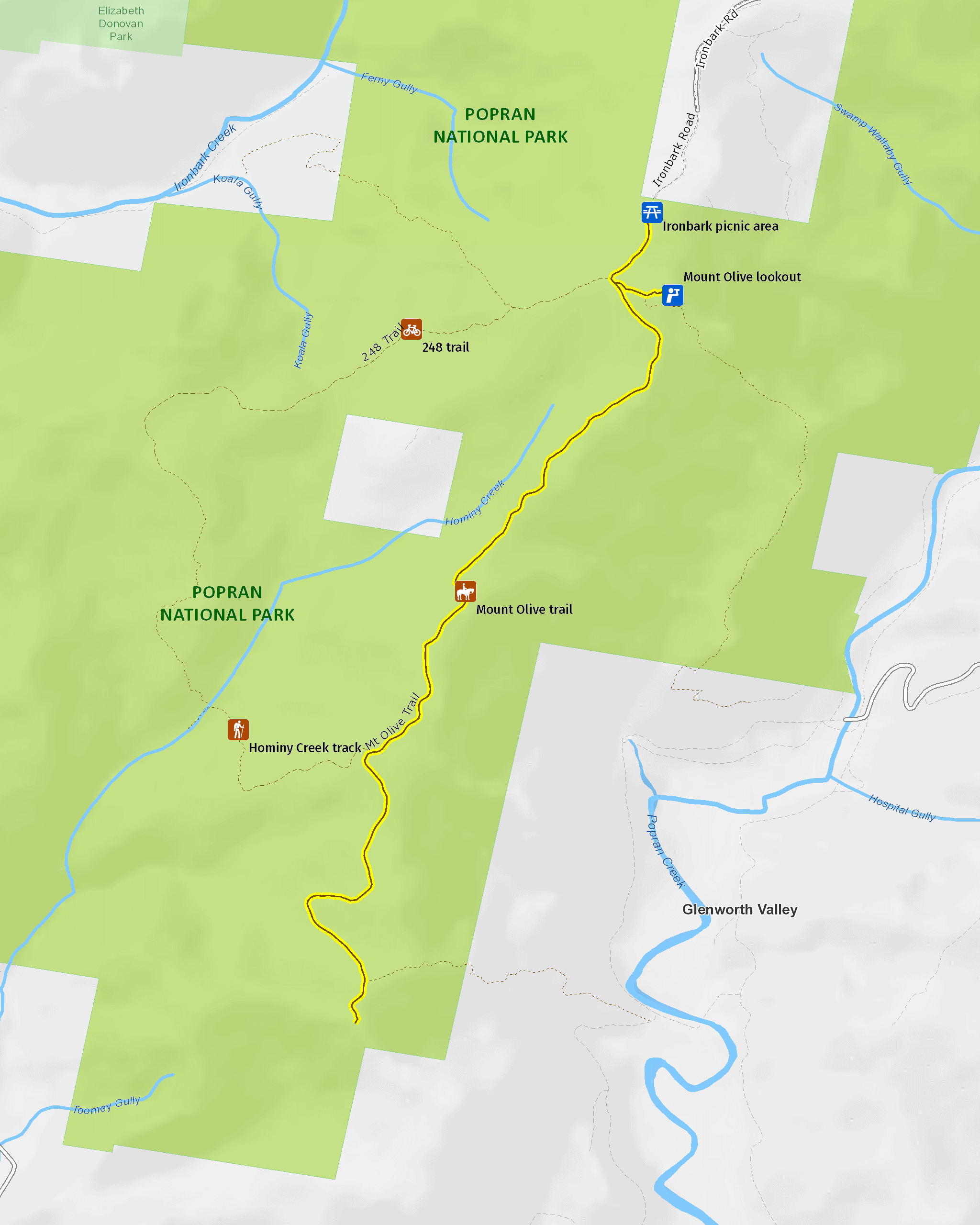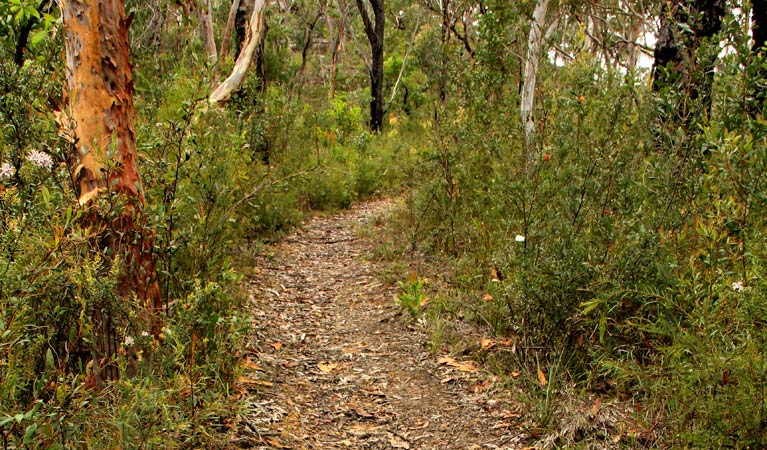Mount Olive trail
Popran National Park
Overview
Whether you love horse riding or mountain biking, Mount Olive trail in Popran National Park on the NSW central coast is a wonderful place to experience magnificent views of the Glenworth Valley.
- Where
- Popran National Park in Sydney and surrounds
- Distance
- 4km one-way
- Time suggested
- 1hr 30min
- Grade
- Medium
- Please note
- Please read the code of practice for horse riding in parks before you set out.
- If you're mountain biking and you need to cross over a walking track, please dismount and carry your bicycle or leave it and continue on foot.
- Mount Olive trail starts at Ironbark picnic area at the end of Ironbark Road. This area has a small dirt carpark and it's not recommended for low-clearance 2WD vehicles.
- You’ll need to bring drinking water as Ironbark picnic area only has tank water for washing hands.
Starting at Ironbark picnic area, Mount Olive trail is the ideal way to see magnificent views of Glenworth Valley and Popran National Park. Whether you're walking, mountain biking or horse riding, the songs of kookaburras and black cockatoos will encourage you along the way.
Once you're on the trail, you can take a short detour to Mount Olive lookout - although this is not a long walk, it's a steep climb as you approach the summit. But once you're there, take a deep breath, and enjoy the superb views over surrounding forests and distant ridgelines. The trail continues past Mount Olive for 3.5 km for more spectacular views over Hawkesbury River.
Map

Map legend

Local alerts
For the latest updates on fires, closures and other alerts in this area, see https://www.nationalparks.nsw.gov.au/things-to-do/horse-riding-trails/mount-olive-trail/local-alerts
Park info
- in Popran National Park in the Sydney and surrounds region
Popran National Park is always open but may have to close at times due to poor weather or fire danger.
Visitor info
All the practical information you need to know about Mount Olive trail.
Maps and downloads
Learn more
Mount Olive trail is in Popran National Park. Here are just some of the reasons why this park is special:
A haven for wildlife

The increasingly rare, untouched freshwater streams and mangroves of the Hawkesbury river are a sanctuary for the many animals that live there. If you're an avid birdwatcher, you might catch glimpses of glossy black cockatoos and masked owls in the park's tall forests and wet gullies. You are unlikely to see the nocturnal yellow-bellied glider during the day, but you might be lucky to hear their distinctive growling call, it's been recorded to have been heard up to 500m away.
- 248 trail 248 trail is a popular horse riding and mountain biking track which meanders through Popran National Park in the NSW Central Coast hinterland.
Outdoor adventurer's playground

Popran National Park offers an immense range of opportunities for recreation in a beautiful Australian bushland and river setting. Offering visitors expansive landscapes and gorgeous water views, it is one of only a few parks on the Central Coast that caters for horse riding and mountain biking. Both the 248 trail and the Mount Olive trail can be explored by horse or by bike, and you can enjoy a picnic or swim to relax after your efforts.
- 248 trail 248 trail is a popular horse riding and mountain biking track which meanders through Popran National Park in the NSW Central Coast hinterland.
- Horse riding adventures in Popran National Park Saddle up with Glenworth Valley Outdoor Adventures for an unforgettable horseback tour along scenic bushland trails in Popran National Park, not far from Sydney.
- Mount Olive lookout Mount Olive Lookout is only a short walk from Ironbark picnic area in Popran National Park on the central coast and offers scenic views over Popran Creek.
Rich Aboriginal heritage

When you visit Popran National Park, you'll see evidence of 11,000 years of rich Aboriginal heritage. From the earth to the waterways, animals and plants, each of these holds a special place in the hearts of the custodians of this land, and the park proudly protects these significant places so we can celebrate Aboriginal culture for generations to come. The park protects a number of Aboriginal sites, like rock engravings, sandstone shelters and foreshore middens. If you find an axe grinding groove in the sandstone, you might be able to imagine how you'd sharpen your tool to catch a meal for your family.
Plants and animals protected in this park
Animals
-

Sugar glider (Petaurus breviceps)
The sugar glider is a tree-dwelling Australian native marsupial, found in tall eucalypt forests and woodlands along eastern NSW. The nocturnal sugar glider feeds on insects and birds, and satisfies its sweet tooth with nectar and pollens.
-

Yellow-tailed black cockatoo (Calyptorhynchus funereus)
The yellow-tailed black cockatoo is one of the largest species of parrot. With dusty-black plumage, they have a yellow tail and cheek patch. They’re easily spotted while bird watching, as they feed on seeds in native forests and pine plantations.
Plants
-

Gymea lily (Doryanthes excelsa)
The magnificent Gymea lily is one of the most unusual Australian native plants, found only along the coast and surrounding bushland of the Sydney Basin, from Newcastle to Wollongong. In spring this giant lily shoots out spectacular red flowers that can reach heights of 2-4m.
-

Smooth-barked apple (Angophora costata)
Smooth-barked apple gums, also known as Sydney red gum or rusty gum trees, are Australian native plants found along the NSW coast, and in the Sydney basin and parts of Queensland. Growing to heights of 15-30m, the russet-coloured angophoras shed their bark in spring to reveal spectacular new salmon-coloured bark.
-

Grass tree (Xanthorrea spp.)
An iconic part of the Australian landscape, the grass tree is widespread across eastern NSW. These Australian native plants have a thick fire-blackened trunk and long spiked leaves. They are found in heath and open forests across eastern NSW. The grass tree grows 1-5m in height and produces striking white-flowered spikes which grow up to 1m long.

